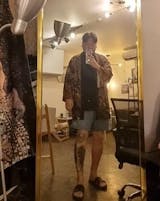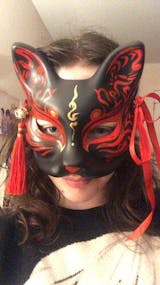
Unmasking Tradition: Exploring the Edgy Allure of Kitsune, Oni, and Samurai Masks
INTRODUCTION
Japanese culture showcases many captivating visual languages deeply rooted in the nation's heritage. These artistic expressions have inspired countless artists since the 20th century to delve into the fascinating and diverse aspects of Japanese culture focusing on Japanese masks that we can all truly appreciate.
History of The Japanese Mask and Japanese Folklore
The long-standing tradition of wearing masks is a cherished and iconic element of Japanese culture. For centuries, masks have played a significant role in Japan, with their origins tracing back to at least the 6th century.
Throughout history, Japanese masks have served multiple purposes. Initially, they were used in religious ceremonies and rituals to protect against evil spirits. In contemporary times, masks have found diverse applications. They are featured prominently in traditional Japanese theater, add vibrancy to festivals and carnivals, and have even become fashionable accessories for everyday wear.
Let's explore the fascinating world of traditional Japanese masks! From the iconic fox masks to the captivating kabuki and charming cat masks, we'll dive into one of Japan's most beloved art forms. Discover the rich history, various types, and their uses in past and contemporary eras. So, keep reading to unravel the mysterious power of traditional Japanese masks!
Japanese Mask: Oni Masks
Japanese Demon Mask
The Oni mask, derived from Japanese folklore, is renowned as the most iconic Japanese mask. It represents demon-like creatures and holds a significant place in Japanese culture.
The Oni mask is renowned for its menacing expression. Sharp fangs and horns accentuate it.
What Does the Oni Mask represent?
These masks are significant in Japanese folklore, representing power, protection, and strength. Inspired by ancient Japanese mythology, the origin of these masks can be traced back to the supernatural beings known as "Oni." These mythical creatures were tasked with upholding justice and punishing those who engaged in immoral behavior or committed crimes.
These masks were traditionally adorned with vibrant pigments and worn during ceremonies to protect against evil spirits and attract good luck. Japanese Oni masks may also be familiar from anime.
During the Setsubun festival, the dancers and those who celebrate at home with their families don JapaneseOni masks. This cultural tradition adds a touch of mystique and excitement to the festivities, creating a vibrant and memorable experience for all involved.
What is the Oni Mask?
The Japanese Oni mask possesses a distinctive, fearsome, and artistically captivating aesthetic, skillfully portraying mythological creatures. These masks often depict ogres or demons, exuding a unique and evocative essence.
Japanese Oni Mask

$44.90
Wear the Legend—Rule the Night with the Japanese Oni Mask Unleash the power and mystique of ancient Japanese folklore with the Japanese Oni Mask—a striking piece of wearable art that fuses tradition with an unapologetically bold edge. Inspired by the… read more
Type of Yokai
Yōkai is used in Japanese folklore to describe various types of supernatural monsters. These entities exhibit many characteristics, from malevolent tricksters to benevolent beings that bestow fortune and luck upon those they encounter. Their appearance can vary greatly, ranging from animalistic forms to resembling regular humans and even encompassing inanimate objects or indescribable shapes.
Yōkai are often characterized by their spiritual or supernatural abilities, with shapeshifting being the predominant trait attributed to them. These mystical beings possess the power to transform their appearance, adding an air of intrigue and fascination to their mystique.
There are four types of Yōkai
- The Four Sacred Beasts
- Monsters (Bakemono)
- Ghosts (Yūrei)
- Objects (Tsukumogami)
What does the Oni Mask mean?
- Fear
- Deception
- Vengeance
- Hatred
When were the Oni Masks made?
The Oni mask is said to have originated during Japan's Edo period, showcasing a rich cultural heritage and artistic expression.
Why the OniMasks were worn?
Oni, or demons, are prominent in Japanese folklore and culture, permeating numerous literary works and artistic creations. These mythical beings often take on the role of antagonists, captivating audiences with their presence and contributing to the rich tapestry of stories and legends.
Known for their frightening power, Oni are revered beings. The Oni mask believed to safeguard against evil spirits and imbue the wearer with strength in combat, carries a rich history. Today, this iconic mask is prominently featured in traditional Japanese theater and is a beloved motif in Japanese art.
How many Oni Masks are there?
3 Types of Oni Masks
Nowadays, Oni masks are commonly found adorning theaters and festivals. These vibrant masks exhibit intricate designs, often exaggeratedly portraying demons or ogres. Let's explore the three distinct types of Oni masks:
1. Hannya Mask
This type of Oni mask is the most frequently encountered, often found in black or red hues. It symbolizes a woman consumed by an evil spirit or demon. These masks are intended to evoke intimidation and fear, making them a popular choice for actors portraying villainous characters in plays.
2. Kabuki Mask
Kabuki masks, traditionally white, represent the visages of mythical creatures or animals. These masks find their place in the theater, predominantly worn by protagonists and actors portraying comedic roles.
3. Noh Mask
These masks, often painted white, symbolize the faces of humanity. In theatrical performances, they grace actors' faces, portraying noble personas or characters destined for tragic demise.
Why did Samurai Wear Oni masks?
Warriors and samurai adorn the Oni mask as a potent emblem of strength and power. This remarkable mask also holds deep associations with the deity of war, Oni-no-Kami.
Oni Mask Tattoos
The Oni mask holds significant cultural importance in Japan. It is a popular tattoo design among those who acknowledge the existence of both good and evil forces and the various powers that envelop us. It serves as a symbol of protection for individuals with faith in the spiritual realm. Oni mask tattoos are popular in Japanese tattoo art and carry significant symbolism.
Oni Mask and Snake Tattoo
Combining the Oni mask with a snake in a tattoo design can carry several meanings. Snakes are powerful symbols in many cultures, often representing transformation, rebirth, and healing due to their ability to shed their skin. In this context, the Oni mask and snake tattoo could signify overcoming past hardships or emerging stronger after challenging times.
Oni Maskand Dragon Tattoo
The dragon is another essential element in Japanese tattoo art, symbolizing strength, wisdom, and prosperity. Combining the Oni mask with a dragon can represent a balance of contrasting traits. While the Oni embodies ferocity and power, the dragon signifies benevolence and wisdom. This tattoo might reflect the wearer's ability to harness both sides of their nature, embracing their strength and power while showing compassion and wisdom.
Are Oni Mask Tattoos Offensive?
Oni mask tattoos, in and of themselves, are not inherently offensive. However, like any tattoo or artwork that draws inspiration from another culture, it is essential to approach them with sensitivity and respect for their cultural origins and meanings.
For some individuals of Japanese heritage, these tattoos can be a source of pride and a connection to their cultural heritage. The potential for offense arises when these tattoos are appropriated or misused without understanding or appreciating their cultural context. If someone from a different cultural background were to get an Oni mask tattoo without knowledge of or respect for its origins, it could be seen as cultural appropriation, which can be offensive to those who hold the symbols sacred.
What's the Difference between Hannya and Oni Masks?
Hannya and Oni masks are iconic elements in Japanese traditional arts, particularly in Noh Theater and tattoo culture. They appear somewhat similar at first glance, but they represent different entities and carry distinct meanings:
Hannya Mask
The Hannya mask is a key figure in Noh Theater, a traditional Japanese musical drama with deep historical roots. The mask portrays a female demon, a "Hannya," filled with intense jealousy and rage due to a tragic love affair. The Hannya character is often depicted as a woman who transforms into a demon due to her overwhelming emotions.
Oni Mask
As discussed earlier, the Oni mask represents a fearsome demon or ogre in Japanese folklore. Oni are powerful and often malevolent creatures, playing various roles in different cultural contexts. In some traditions, Oni are seen as evil beings that cause harm; in others, they are considered protectors who ward off evil spirits.
In summary, while the Hannya and Oni masks represent supernatural beings in Japanese folklore, they are distinct entities with unique cultural and symbolic significance. The Hannya mask portrays a female demon driven by emotions like jealousy. In contrast, the Oni mask represents a fearsome and powerful demon or ogre, sometimes as a protective force.
Japanese Mask: Samurai Mask

Japanese Samurai Mask History
The history of Japanese Samurai masks, known as "menpo" or "mempo," is deeply rooted in the nation's warrior culture and traditions. Dating back to the feudal era, which spanned from the 12th to the 19th centuries, these masks played a crucial role in the lives of samurai warriors.
Originally designed to strike fear into enemies during battle, Samurai masks evolved from simple face coverings to intricate works of art, reflecting the aesthetic and artistic sensibilities of the time. Made from various materials like iron, leather, and lacquered metal, they protected the samurai's face while concealing their identity on the battlefield.
Each mask was uniquely crafted, often featuring fierce expressions with eyebrows, snarling mouths, and menacing mustaches. As time passed, the designs became more elaborate and sophisticated, reflecting the status and individuality of the wearer.
With the decline of the samurai class in the 19th century, the significance of these masks transformed from practical battlefield gear to symbols of Japanese martial heritage and cultural heritage. Today, they continue to be appreciated as collectibles and historical artifacts, embodying the bravery and valor of Japan's legendary samurai warriors.
Japanese Samurai Mask

$44.90
The Samurai Mask You've Been Looking For Unleash your inner warrior with our Japanese Samurai half-mask! Crafted from high-quality resin, this mask is a stunning and durable addition to any cosplay or festival outfit. The breathable material inside ensures comfort… read more
It's Meaning
Japanese Samurai masks hold profound cultural and symbolic significance. These masks were not merely utilitarian armor pieces; they carried deeper meanings beyond the battlefield.
Firstly, the Samurai mask represented the warrior's courage, bravery, and dedication to their code of honor, known as "bushido." Wearing a fearsome mask instilled fear in the enemy and showcased the samurai's unwavering resolve and readiness to confront death in battle.
Secondly, masks provided a sense of anonymity, allowing samurai to fight without revealing their identity. This anonymity was crucial as it emphasized the individual's devotion to their duty and clan over personal fame or recognition.
Moreover, masks were an artistic expression of the wearer's status and identity. The elaborate designs and craftsmanship showcased the wealth and taste of the samurai. At the same time, unique features conveyed their individuality and personality.
Lastly, in modern times, Samurai masks have become cherished cultural artifacts, preserving the historical legacy of Japan's warrior heritage. As symbols of strength, discipline, and honor, these masks continue to inspire admiration and respect for the noble traditions of the samurai class.
Samurai Mask Tattoo Meaning
A Samurai mask tattoo carries profound meanings that embody the spirit of the ancient Japanese warriors. It symbolizes strength, courage, and the readiness to face challenges head-on, reflecting the samurai's indomitable spirit in the face of adversity. The mask's fearsome expression represents the warrior's determination to instill fear in enemies and protect their honor.
The tattoo can also signify loyalty, as samurai were devoted to their lords and masters. Additionally, the mask tattoo may represent the duality of human nature, reminding the wearer of the balance between aggression and restraint. Overall, the Samurai mask tattoo is a powerful reminder of the samurai's unwavering principles, making it a popular choice for those seeking to embody the warrior's virtues and embrace their legacy.
Japanese Mask: Kitsune Mask

What is a Kitsune or Japanese Cat Mask?
Kitsune or Japanese cat masks are significant in Japanese folklore and traditional arts. These masks portray foxes, believed to possess magical powers and intelligence in Japanese mythology. Kitsune masks are commonly used in traditional Noh and Kyogen theater performances, representing fox spirits capable of shapeshifting and possessing humans.
The masks exhibit various expressions, depicting these mythical creatures' playful, cunning, or malevolent nature. Beyond theater, Kitsune masks have become popular symbols in modern Japanese culture, often associated with prosperity, good fortune, and protection against evil spirits. They continue to captivate people with their rich cultural history and captivating allure.
The Kitsune Myth
It's said that a woman got married to a fox spirit. She didn't know he could turn into a fox whenever he was in human form when she wasn't looking. But one day, she caught him in his foxy shape! She cleverly made a mask to ensure she could always recognize him.
What Type of Mask is a Kitsune Mask?
The Kitsune mask is typically characterized by its distinct features, which include a fox's facial expressions and attributes. These masks are often made of wood or other materials. They are commonly used in traditional Japanese performing arts, such as Noh, Kyogen, and Kagura plays, as well as in festivals and ceremonies.
When Was the Kitsune Mask Made?
The origin of Kitsune masks is deeply rooted in Japanese history and folklore, dating back centuries. The precise date when the first Kitsune mask was made is difficult to determine due to the mask's ancient origins and the lack of specific historical records. However, Kitsune masks in traditional Japanese performing arts and religious ceremonies began during the Nara period (710-794) or Heian period (794-1185).
During these periods, Japanese folklore and Shinto beliefs intertwined, and the fox spirit (Kitsune) emerged as a prominent figure in their stories and rituals. Kitsune masks originated in the 14th century, debuting in two forms of traditional Japanese theater: Noh, a classical music drama, and Kyogen, a lighthearted and comedic theatrical performance.
How to Wear a Kitsune Mask?
Foxes are messengers of Inari, leading to the annual festivals held during rice harvesting. Many individuals purchase Kitsune masks to partake in these celebrations fully. Apart from the festivities, the Kitsune mask's distinctive design and craftsmanship contribute to its global popularity. There are no rigid guidelines for wearing these masks, making them accessible to anyone who can afford them.
However, the Kitsune masks hold cultural significance. They are often used in specific contexts, so it's important to approach wearing them with sensitivity and respect for Japanese traditions and folklore. Suppose you need clarification about the appropriate use of the mask. In that case, it's best to seek guidance from those familiar with the cultural practices surrounding its use.
Kitsune Mask Tattoo Meaning
Kitsune mask tattoos represent the untamed facets of one's personality. The Kitsune, known as tricksters, were believed to influence weather phenomena like rain on a sunny day. Masks generally embody adopting or shedding roles at one's discretion. Such tattoos often signify the wearer's mischievous nature and spirited playfulness, which only a select few will have the chance to observe and understand.
Kitsune Mask Anime – Demon Slayer
Urokodaki, a character in "Demon Slayer" (Kimetsu no Yaiba), possesses a hobby of crafting unique masks that he presents to his beloved students. These masks, known as "warding masks," hold extraordinary properties as they are inscribed with his personal protection spells. Urokodaki's fondness for foxes is evident through his preference for creating Kitsune masks, adding a touch of symbolism to the masks he bestows upon his students.
Many of Urokodaki's students, including Sabito and Makomo, tragically didn't survive the final selection arc. Fearing for Tanjiro's safety, Urokodaki didn't wish to lose him either. However, witnessing Tanjiro's unwavering determination, Urokodaki decided to entrust him with a Kitsune mask, imparting his blessings upon the determined young boy.
Are Kitsune Mask, also Called Japanese Cat Mask (Japanese Festival Mask)?
The term "Kitsune" refers to a fox in Japanese. These creatures are believed to possess intelligence on par with humans and are commonly associated with magic and cunning trickery. In various tales, Kitsune are said to have the power to assume a human form, and they are renowned for their shapeshifting abilities, capable of transforming into other animals such as wolves, dogs, and cats. Kitsune masks are sometimes also referred to as Japanese Cat masks.
CONCLUSION
In conclusion, the enchanting Japanese mask world of Oni, Kitsune, and Samurai masks unveils a captivating odyssey into the very essence of Japanese culture, folklore, and history. Each mask encompasses profound significance, symbolizing diverse facets of the human experience and embodying potent archetypes.
The Oni mask epitomizes the eternal battle between good and evil, serving as a poignant reminder of the repercussions of our choices and actions. On the other hand, the Kitsune mask depicts the mysterious fox spirits, symbolizing their cunning, intelligence, and ability to transform, encapsulating the intricate facets of human nature. In contrast, the Samurai mask embodies the essence of honor, loyalty, and courage, providing a glimpse into the disciplined world of the warrior class.
Exploring the cultural significance of Japanese masks not only enhances our appreciation for Japanese artistry and deepens our connection to their profound meanings. The enduring popularity of these masks serves as a testament to their timeless allure and continued relevance in the modern world.
Shop our collection of JAPANESE MASK!






